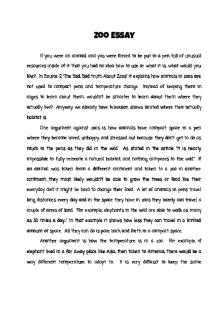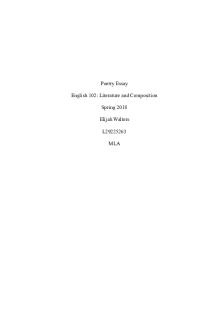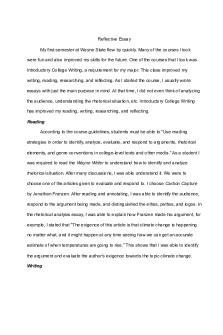102 term2 essay - Grade: B- PDF

| Title | 102 term2 essay - Grade: B- |
|---|---|
| Course | English Language |
| Institution | Lancaster University |
| Pages | 8 |
| File Size | 122.5 KB |
| File Type | |
| Total Downloads | 52 |
| Total Views | 154 |
Summary
Intertextuality...
Description
Defining romantic comedy genre with the analysis of the film
10 things I hate about you
1. Introduction
Genre is kinds, types and forms of film, distinguished by content, style and features. (Grant, 1977, p.39). Genres have specific features and functions that distinguish them from each other. Genre classifies different types of texts, dividing things into small classes (Grant, 1977, p.42). Genre is important in order to identify what kind of film it is. According to Grant (1986, P.29), the main function of genre is to establish a bridge between the author and the audience. Therefore, media producers can produce media text for the targeted audience and consumers can choose the media text they want to consume. Genre helps audience know which type of genre they are watching so as to understand the information it conveys because they may have certain expectations before watching. The film I want to discuss in this essay is called 10 things I hate about you, which is a romantic comedy. The remainder of this essay will be divided into three sections. I will begin by discussing the features of romantic comedy. What follows is a detailed systematic analysis of the reason why 10 things I hate about you belongs to the romantic comedy genre. I will then go on to comment on intertextuality 1
with examples.
2.1 Features of romantic comedy
Romantic comedy is one of the most enduring film genres. Every year new romantic comedies are released with some earliest examples in film history. Its popularity has certainly experienced some ebbs and flows, however, like all major genres, it proves permanent resilience. The audiences still enjoy the traditional ingredients of romantic comedy and the blueprint.
The production of laughter is the basic narrative dynamic in any form of comedy. Romantic comedy focuses on the lives of teenagers: their daily activities, conflicts and desires (McDonald, 2007, P. 6). According to Grant (1977, p.43), genres change over time. The essence of the genre is to repeat some of the basic existing materials but add new elements. Like all other main genres, the romantic comedy has developed and have had some interesting and successful branches that continue to enliven and attract new audiences (McDonald 2007, P.43). According to Mortimer (2010, P. 8), romantic comedy can be seen as a mixture of romance and comedy genres, characterized by the development of relationships leading to a happy ending as a comedy. The pursuing of love is the dynamic of romantic comedy. McDonald (2007, P.23) points out that the predominant theme is "The battle of gender", which is a core 2
part of romantic comedy genre. The central couple usually initially against or dislike each other due to social status, wealth, conflicting lifestyles and attitudes from the beginning but they realize their love for each other in the end due to the consequences of various complications and misunderstandings. (Fredric, 1975, P.15). This is the basic model of many romantic comedies. All of these plots contribute to a happy ending. The audience will have expectations of seeing a happy ending before start watching it and enjoy the journey with this aim.
2.2 The reasons why 10 things I hate about you belongs to the
romantic comedy genre
Romantic comedy has a very unique narrative structure. Boys meet girls and they meet all sorts of obstacles set to prevent them from being together. Coincidences and complications are followed, which eventually leads the couple to realize they should have been together. Consistent with the comedy genre, the story end with a happy ending. There are some elements and conventions that compose the romantic comedy in the film 10 things I hate about you.
One of the conventions is characters. The two protagonists who are Kat and Patrick fall in love in the film. Another convention area is setting. This film talks about a 3
story that takes place at a contemporary American high school called Padua High School. Many youth high school movie settings can be found in the film, including the “crazy” family gathering sequence and at the high school prom. Besides, each genre has its own storyline. The storyline of the romantic comedy 10 things I hate about you are following a young woman who does not like or trust men, but as the story continues, she falls in love with the man in her life. The author throws in turns to bulk the story. The father in that movie is an obstetrician who is worried about teenage pregnancy. He does not allow Bianca to have a boyfriend until her abominable sister has her own one, which makes the situation seems unlikely because Kat is a social disaster. Joey pays Patrick to take out Kate. This situation is used to bring together two central figures and their conflicting characters into a comic collision and start. What is more, another convention is themes. This film also plays the common teen romantic comedy themes: high school balls, awkward poems, and dating on the paintball stage. Moreover, narrative dynamics is another convention. It involves conflicts, challenges and embracement midway through which needs to be overcome. The central couple is characterized by paradox. In terms of visual style, light colors like yellow, blue and white are widely used to create the bright and breezy atmosphere. Besides, upbeat sound is stereotypically used as an convention in romantic comedies. The pop song Can't Take My Eyes Off You is featured as part of the film to fit the genre.
4
2.3 Intertextuality
Intertextuality is the concept which states that texts are formed in relation to one another either directly or indirectly (Altman, 1999). This is often shown through the use of references to other texts, genres and discourses. It is a work that shows the relationship with another work rather than being original. Every text is a mosaic of reference to another. Therefore, the link between the original text and the new text reminds people something that they recognize, so they can make the link and realize something (Grant 1986, P.28).
The teenage romantic comedy 10 things I hate about you is an adaption of the original The Taming of the Shrew which is a William Shakespeare's play. The film serves to highlight themes from the play. The film 10 things I hate about you was then adapted into a very popular TV show with the same name. This series of adaptations indicates the extensive use of intertextuality in media genres.
Intertextuality is widely used in the choices of recreating the original text The Taming of the Shrew into the film grouped as a teenager romantic comedy genre. Some plots have been changed or removed in 10 things I hate about you from Taming but the film still manages to capture themes and the spirits from the original drama. For instance, the setting is transferred from the Italian city of Padua to the place called “Padava Heights”. What is more, 10 things I hate about you uses many of the same names, 5
such as Kat and her sister Bianca. The first names of the main characters are variants of The Taming of the Shrew counterparts: Kate becomes Kat and Petrozzi becomes Patrick. Moreover, although the story in the film 10 things I hate about you is happening in a modern world as well as the languages, some lines from Taming is retained it as a way to sneak into the narration. Shakespeare's famous saying: “I burn, I pine, I perish.” came out from Cameron’s mouth in the film, humorously showing his passion when he first sees Bianca. Besides, the plot elements are preserved, such as the father's plot. His little daughter is not permitted to marry unless her older daughter gets married. The plot is transformed into a modern background where the younger daughter is not allowed to date until her sister does. Moreover, the class division in Taming can be reflected by the trope of high school cliques, showing that the characters with higher social status in the play are more popular among students in the film. In addition, the poem which Kat writes about Patrick and recites in the class linked to Katherine's last speech in The Taming of the Shrew, because she braved public mortification and cried publicly.
Intertextuality makes texts consist of a series of conditions that the audience can recognize it from other films of this genre (Grant 1986, P.311). Knowing intertextuality helps people be aware of how it is used in different pieces of art work. It provides people with the opportunity to be inspired by the original work, take the genre plot, the ideas or some of the characters and then bring them into a different context. As a result, texts are reinterpreted with new thoughts on them. Understanding 6
intertextuality is important for a better understanding of the text. Being aware of intertextuality results in a richer reading or watching experience, which will bring new interpretations. Overtime, the development of intertextuality will have a significant impact on the genres of films.
3. Conclusion
In conclusion, genre groups things into categories. Media genres change over time. As time goes by, genres combine different elements and conventions from different genres to form new genres. Intertextuality plays a significant role in genre change, resulting in more complex hybrid genres, thus the romantic comedy is the mixture of romance and comedy. Understanding the media genres, their evolution and changes in popularity and production is of great significance to resonate with the audience.
References Altman, R. (1999). Film/genre. London: BFI Publishing. Fredric, J. (1975). Magical Narratives: Romance as Genre. Baltimore: Johns Hopkins 7
University Press. Grant, B. (1986). Film genre reader. Austin: University of Texas Press. Grant, B. (1977). Film genre: theory and criticism. Metuchen, N. J: Scarecrow Press. McDonald, T. (2007). Romantic Comedy: Boy Meets Girl Meets Genre. New York. Chichester. West Sussex: Columbia University Press. Mortimer, C. (2010). Romantic comedy. Abingdon, Oxon: Routledge.
8...
Similar Free PDFs

102 term2 essay - Grade: B-
- 8 Pages

ENG 102 - Grade: b
- 6 Pages

Rogerian Essay - Grade: B
- 2 Pages

Zoo Essay - Grade: B+
- 2 Pages

Causation Essay - Grade: B
- 4 Pages

Final Essay - Grade: B+
- 12 Pages

Propaganda Essay - Grade: b
- 4 Pages

Poetry Essay - Grade: B
- 5 Pages

Galileo Essay - Grade: B+
- 6 Pages

Fiction Essay - Grade: B
- 7 Pages

EPQ Essay - Grade: B+
- 10 Pages

Law essay - Grade: B
- 9 Pages

Persuasive Essay - Grade: B
- 3 Pages

Evicted Essay - Grade: B+
- 3 Pages

Charities essay - Grade: B+
- 13 Pages

Reflective Essay - Grade: B
- 4 Pages
Popular Institutions
- Tinajero National High School - Annex
- Politeknik Caltex Riau
- Yokohama City University
- SGT University
- University of Al-Qadisiyah
- Divine Word College of Vigan
- Techniek College Rotterdam
- Universidade de Santiago
- Universiti Teknologi MARA Cawangan Johor Kampus Pasir Gudang
- Poltekkes Kemenkes Yogyakarta
- Baguio City National High School
- Colegio san marcos
- preparatoria uno
- Centro de Bachillerato Tecnológico Industrial y de Servicios No. 107
- Dalian Maritime University
- Quang Trung Secondary School
- Colegio Tecnológico en Informática
- Corporación Regional de Educación Superior
- Grupo CEDVA
- Dar Al Uloom University
- Centro de Estudios Preuniversitarios de la Universidad Nacional de Ingeniería
- 上智大学
- Aakash International School, Nuna Majara
- San Felipe Neri Catholic School
- Kang Chiao International School - New Taipei City
- Misamis Occidental National High School
- Institución Educativa Escuela Normal Juan Ladrilleros
- Kolehiyo ng Pantukan
- Batanes State College
- Instituto Continental
- Sekolah Menengah Kejuruan Kesehatan Kaltara (Tarakan)
- Colegio de La Inmaculada Concepcion - Cebu